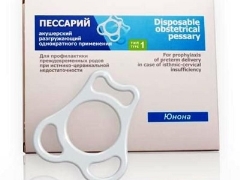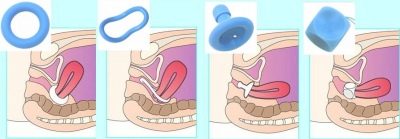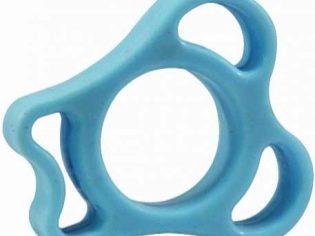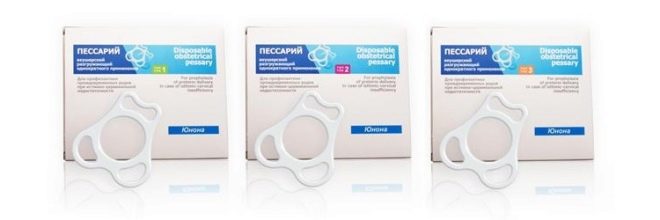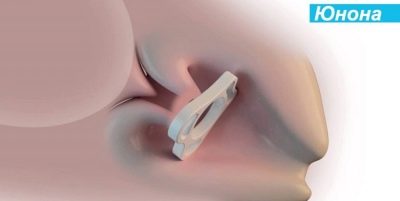Obstetric pessary "Yunona"
In order for the pregnancy to end favorably, in some cases, gynecologists are forced to resort to the formulation of special gynecological tools. One of them is the obstetric pessary "Juno".
When is it applied?
Specialists call a special obstetric device that is inserted into the vagina to hold the pelvic organs. It can be made of rubber or silicone, as well as other modern materials. The doctor is forced to resort to the formulation of obstetric pessary in the event that the woman has a threat of spontaneous miscarriage.
The most common clinical indicator for setting obstetric pessary is cervical insufficiency. In this case, the installation of a special tool is carried out, as a rule, after 20 weeks of pregnancy.
Also pessary may apply in the treatment of omission or prolapse of the pelvic organs. In such a situation, wearing this obstetric product is necessary for quite a long time.
This product is also used in case of incomplete healing of the sutures after the correction of isthmic-cervical insufficiency. In some cases, it is shown in multiple pregnancies.
Product Parameters
This device looks like a plastic ring curved shape. A large base has a larger radius. During the production, it will be turned to the rectum. The small base will be turned to the heart. The concave surfaces of the device do not allow strong pressure on the bladder and rectum.
There are several holes inside the pessary. Central is for the cervix. Several openings located next to it are necessary for normal discharge of vaginal secretions. All sides of the pessary are rounded. Between the holes there are special jumpers. They provide the necessary structural strength.
The material for the manufacture of these obstetric devices is inert plastic. It is believed that such products are less likely to cause inflammation in the intimate area than similar rubber.
Manufacturers make these devices in three sizes at once. Interestingly, after the introduction of the product inside it begins to gradually change its softness.
The medical company "Simurg" has developed several versions of these obstetric devices:
Type 1 it is used for the most initial manifestations of uterine prolapse or for minor pathologies of the reproductive organs. As a rule, such states are a manifestation of a mild degree of functional impairment. The outer diameter of the product is 60.5-65.5 mm. This type of pessary is the smallest of the presented line of tools.
Type 2 has already large sizes. It is used to correct moderately pronounced disorders associated with genital prolapse. It is prescribed for pathologies accompanied by 2-3 degrees of severity. The outer diameter of the product is 65.5-70.5 mm.
Type 3 can be used in case of pronounced pathologies of the intimate zone. The outer diameter of the product is 70.5-75.5 mm.
How is the production?
Before you install a pessary, it is very important to assess the state of the internal genital organs in a pregnant woman.For this, she should definitely visit a gynecologist. During the gynecological examination on the chair, the doctor will be able to identify pathologies that may be contraindications for the installation of the product.
For example, it is not possible to install an obstetric device in acute inflammatory processes in the reproductive organs. First, the doctor will prescribe a complex treatment for the woman to improve the condition of the intimate zone. Only after this the doctor will install the pessary.
With the introduction of the product it is very important to follow all the rules and recommendations of asepsis and antiseptics. Proper processing of tools will help to significantly reduce the possible risk of infection of the female genitals and infection of the baby.
First, the device is inserted in the sagittal plane. When inserted into the vagina, the direction changes and shifts frontally. At the same time its convex side faces the cervix.
During the installation of the device, the doctor necessarily asks the patient about how she feels. It so happens that at the time of introduction of the obstetric device, the woman feels a little soreness or discomfort. Usually these symptoms disappear completely within a few minutes.
Once the installation has been performed, it is very important for the doctor to check how well he did it. To do this, the doctor offers a woman to strain. If the pessary does not fall out, then it is installed correctly. Further when using it no pain in a woman occurs.
If, nevertheless, a woman continues to experience pain, then in this case she should definitely seek advice from her doctor. Perhaps, she needs a smaller product.
In the first month after the installation of the obstetric unloading device, a woman should visit her doctor every 10-14 days. The doctor will evaluate the cost of the pessary and how long it can be used. Also, the doctor will be able to timely notice the conditions that require urgent removal of the device.
It is important to remember that various inflammations can occur while wearing the pessary. In order to reduce the risk of their occurrence, the doctor will definitely recommend a woman to monitor the hygiene and condition of the intimate area.
Opinions of women after use
Reviews of women who have already become mothers and had difficulties with the preservation of the baby, indicate that with the help of obstetric pessary they managed to keep the pregnancy. The use of this device is usually well tolerated.
Only some women noted a slight soreness. The most unpleasant moment, in their conviction, was the direct installation of a pessary by a gynecologist. Further, the obstetric pessary did not cause any inconvenience to them.
Some women say that they could not get this type of product in an ordinary pharmacy. To purchase a pessary, they made an order on the Internet.
In the next video you will find a review of the obstetric unloading pessary "Yunon" manufactured by Simurg Medical Company.
